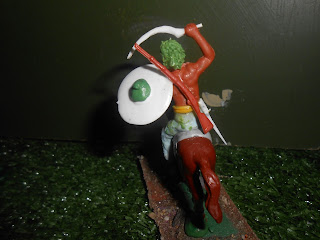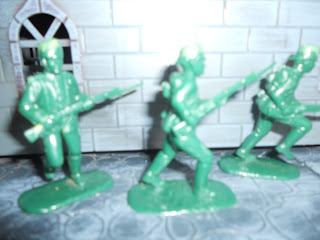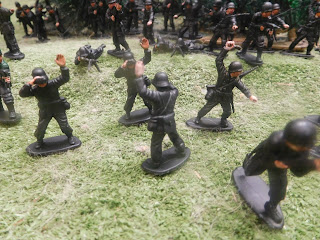Lionian/Abyssinian Conversions
Below are some examples of how my Lionians were converted.
I like the old 60s and 70s Hong Kong Cowboys and Indians, because, although they were inferior copies of made in England brands the plastic has lasted much better than the plastic of the figures they were copied from. In fact I quit liked the HK stuff anyway especially as the cowboys and Indians were often made, at that time, in a more realistic and subdued brown plastic.
On the other hand it was clear that the HK swoppets were nowhere as good as the originals, were often made of a rubbery plastic and the anatomy varied from very good to horrible. The best ones were copies of Britains and especially good was the copy of the Indian Mowhawk head. Others were copies of Cresent, among others. As a small boy I once said to my mother that I should have more Indians than cowboys but my cowboys outnumbered the 'Injuns'. So, sure enough, one day my mother brought home a pile of HK swoppet Indians.
On the other hand it was clear that the HK swoppets were nowhere as good as the originals, were often made of a rubbery plastic and the anatomy varied from very good to horrible. The best ones were copies of Britains and especially good was the copy of the Indian Mowhawk head. Others were copies of Cresent, among others. As a small boy I once said to my mother that I should have more Indians than cowboys but my cowboys outnumbered the 'Injuns'. So, sure enough, one day my mother brought home a pile of HK swoppet Indians.
Only in the last year or so have I begun converting the HK swoppets. Once I needed a lot of Aztecs to fight my Fezians. This time I wanted more Lionians.
The Abyssianian and Sudanese warriors look very similar. The main differences are that the Abyssinians didn't wear the white skull caps unless they were Muslim. Most Abyssinians were and are Christians and may well lay claim to being the first Christian country. They also didn't have the colored patches on their clothing, tended to be bare headed and to have shorter hair. Some warriors of higher status wore lion hair headdresses. White robes, goat hair and baboon hair vests were also worn. Another difference is the sword, with Sudanese commonly having staight brod swords and Abyssinians very curved swords.
Below the Indian figure, which was a copy of Cresent, has a DSG shield added with putty hub. The hair is from putty and a Timpo musket is added. It could also be a more modern bolt action or it could be painted as a more modern weapon.
Now the really fun bit is I found a source of really curvy swords - 'flosspicks'. I discovered that my daughter uses these and was immediately drawn to the curved end of the flosser. At first I thought of scythes for chariots and then I remembered the curved Abyssinaian swords. So I trimmed down the inner part and stem and 'voila', a nice little, lethal chopper. The same thing was done to make scabbards, although these should be blunter.
The Abyssianian and Sudanese warriors look very similar. The main differences are that the Abyssinians didn't wear the white skull caps unless they were Muslim. Most Abyssinians were and are Christians and may well lay claim to being the first Christian country. They also didn't have the colored patches on their clothing, tended to be bare headed and to have shorter hair. Some warriors of higher status wore lion hair headdresses. White robes, goat hair and baboon hair vests were also worn. Another difference is the sword, with Sudanese commonly having staight brod swords and Abyssinians very curved swords.
Below the Indian figure, which was a copy of Cresent, has a DSG shield added with putty hub. The hair is from putty and a Timpo musket is added. It could also be a more modern bolt action or it could be painted as a more modern weapon.
Now the really fun bit is I found a source of really curvy swords - 'flosspicks'. I discovered that my daughter uses these and was immediately drawn to the curved end of the flosser. At first I thought of scythes for chariots and then I remembered the curved Abyssinaian swords. So I trimmed down the inner part and stem and 'voila', a nice little, lethal chopper. The same thing was done to make scabbards, although these should be blunter.
In this particular case below the figure, as yet unpainted, was left bare chested although this practice appears to be less common than with the Dervishes. The figure is hot glued to a card base and sand added onto PVA glue.
I also left the 'necklace' although I usually remove it.Another figure but with a goat skin vest from cotton wool.
My main reference, the Osprey book on Adowa. There is another book based much later on Mussolini's invasion and the Abyssinians clothing changed little except for regulars in European style uniforms in this later war.
You can see the very curved sword brandished by the figure in the middle back.
The main color of clothes was white with brighter colors worn by leaders. Poorer wariors had plain brown shields, not always with hubs. Others were black or, sometimes colored for leaders. They were embellished with gold and silver decoration.
Another curious fact is that even mounted Abyssianians were bare footed and rode with their big toes holding on to the stirrups. I didn't want to spend that much time modelling this but it is n unusual feature to depict.
















Comments
Post a Comment